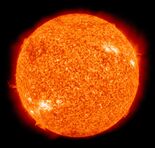Astronomy:Transequatorial loop
In solar physics, a transequatorial loop is a structure present in the solar corona that connects two different regions of opposite magnetic polarity in opposite hemispheres of the Sun. These connected regions are not limited to active regions, but are most commonly found during the times of maximum solar activity, the solar maximum.[1][2]
Transequatorial loops play an integral role in the Babcock Model of solar dynamics and are therefore important to the future study of the solar dynamo.
Babcock Model
The idea of transequatorial loops was first developed by Horace W. Babcock in his 1961 model for the 11 year sunspot cycle. It explains that during each cycle, starting around the time of solar minimum, the Sun's internal, poloidal (parallel with the solar meridian) magnetic field is wrapped around the Sun via solar differential rotation. Over time, this process turns the field from primarily poloidal, to primarily toroidal (parallel with the solar equator) until the toroidal field reaches its maximum strength at the solar maximum. In order for it to return to its initial, poloidal state, Babcock theorized that the magnetic field from different hemispheres, which continuously emerges from the inside of the Sun into the solar atmosphere, would reconnect with each other forming transequatorial loops.[3]
After evidence for the existence of transequatorial loops was first observed in Skylab X-ray data,[4] they were found to be more common during solar maximum then during solar minimum in accordance with the Babcock Model.[1][2]
Characteristics

Transequatorial loops connect regions of opposite magnetic polarity on opposite solar hemispheres. Typically, they connect active regions with inactive regions, but can also connect active regions together and inactive regions together. Some regions may possess multiple transequatorial loops. In addition to this, about one third of all active regions possess at least one transequatorial loop[1] and about one third of those possessing one have it associated with the preceding, or westernmost, polarity of the active region.[2]
Transequatorial loops have also been associated with flare activity[5] and coronal mass ejections.[6]
See also
References
- ↑ 1.0 1.1 1.2 Pevtsov, Alexei A. (March 2000). "Transequatorial Loops in the Solar Corona". The Astrophysical Journal 531 (1): 553–560. doi:10.1086/308467. Bibcode: 2000ApJ...531..553P.
- ↑ 2.0 2.1 2.2 Chen, Jie; Bao, Shudong; Zhang, Hongqi (May 2006). "A Statistical Study of Transequatorial Loops". Solar Physics 235 (1–2): 281–294. doi:10.1007/s11207-006-0072-y. Bibcode: 2006SoPh..235..281C.
- ↑ Babcock, H. W. (March 1961). "The Topology of the Sun's Magnetic Field and the 22-YEAR Cycle." (in en). The Astrophysical Journal 133: 572–587. doi:10.1086/147060. ISSN 0004-637X. Bibcode: 1961ApJ...133..572B.
- ↑ Švestka, Zdeněk; Solodyna, Craig V.; Howard, Robert; Levine, Randolph H. (December 1977). "Open magnetic fields in active regions". Solar Physics 55 (2): 359–369. doi:10.1007/BF00152579. Bibcode: 1977SoPh...55..359S.
- ↑ Harra, Louise K.; Matthews, Sarah A.; van Driel-Gesztelyi, Lidia (20 November 2003). "Evidence of Flaring in a Transequatorial Loop on the Sun". The Astrophysical Journal 598 (1): L59–L62. doi:10.1086/380558. Bibcode: 2003ApJ...598L..59H.
- ↑ Glover, A.; Harra, L. K.; Matthews, S. A.; Foley, C. A. (March 2003). "The association of transequatorial loops in the solar corona with coronal mass ejection onset". Astronomy & Astrophysics 400 (2): 759–767. doi:10.1051/0004-6361:20021886. Bibcode: 2003A&A...400..759G.
Further reading
- Chen, Jie; Pevtsov, Alexei A.; Su, Jiangtao; Erdélyi, Robertus; Deng, Yuanyong; Yang, Shangbin; Song, Yongliang (April 2020). "Formation of Two Homologous Transequatorial Loops". Solar Physics 295 (4): 59. doi:10.1007/s11207-020-01625-z. Bibcode: 2020SoPh..295...59C. https://eprints.whiterose.ac.uk/160097/1/tl_form_rev2_v2.pdf.
- Pevtsov, Alexei A. (June 2004). "Transequatorial Connections: Loops or Magnetic Separators?". Proceedings of the International Astronomical Union 2004 (IAUS223): 521–524. doi:10.1017/S1743921304006726. Bibcode: 2004IAUS..223..521P.
 |



